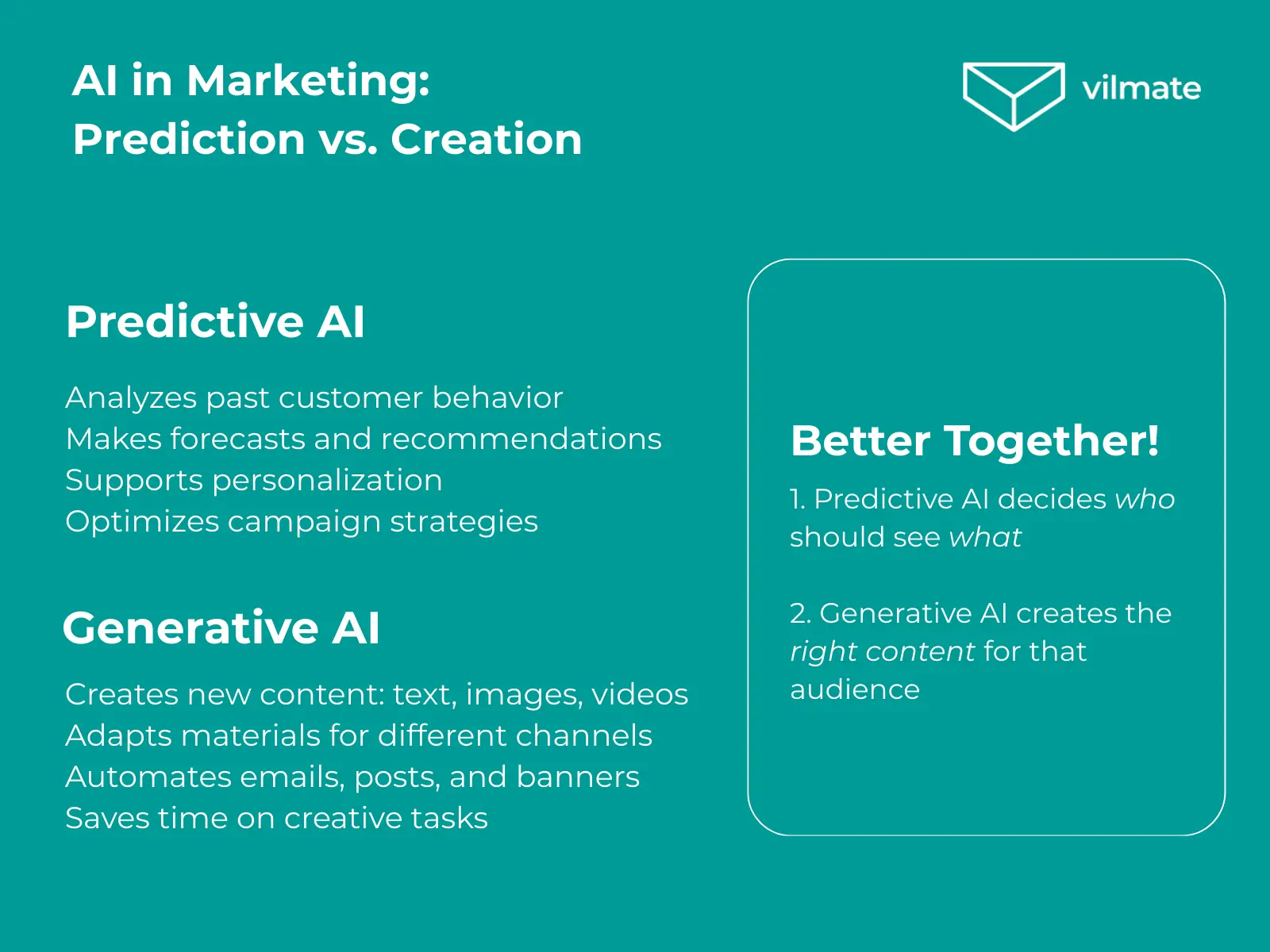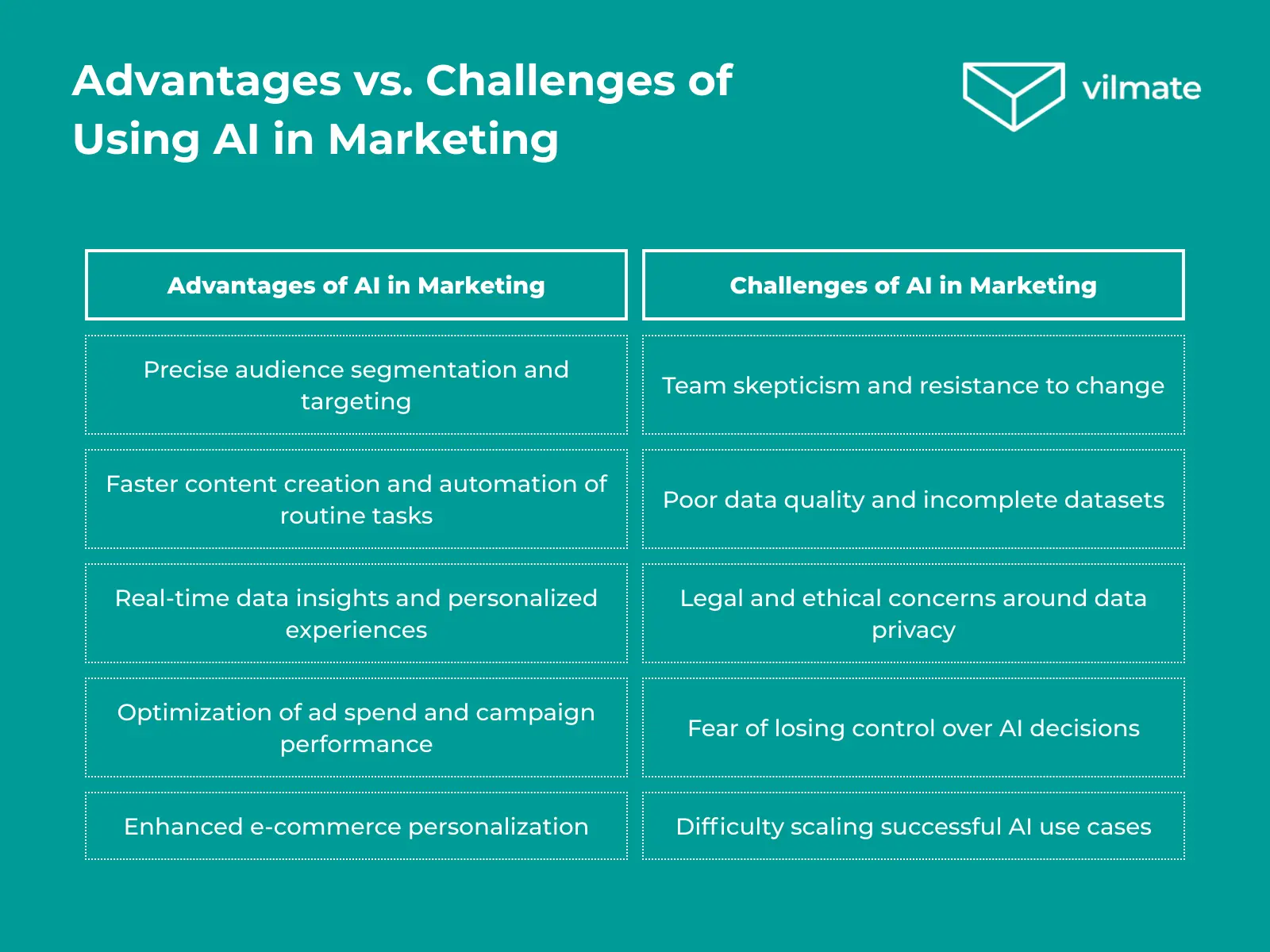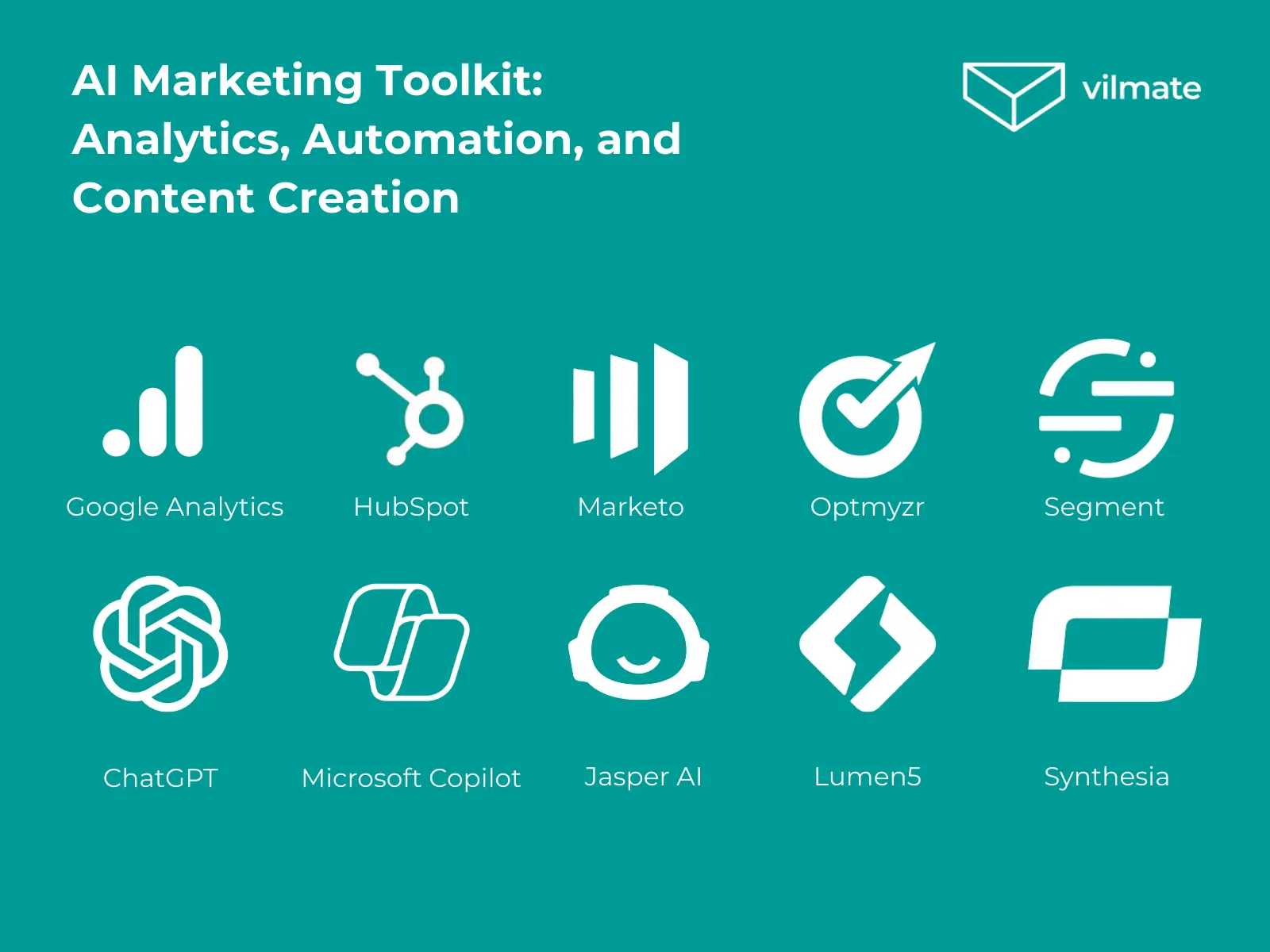How to Use AI in Marketing: From Basics to Advanced Strategies
articlesartificial intelligencemarketingArtificial intelligence has firmly taken root in our lives, especially in the workplace. Programmers, designers, analysts, scientists… almost anyone open to new technology is already using it. In marketing, AI is also becoming a popular tool, helping professionals stay ahead of trends and the competition.
Neuro-linguistic and predictive AI models can give you a real edge — if you use them wisely. But AI in marketing has as many risks as it does benefits, so it’s essential to approach it with care.
In this article, we’ll look at what AI in marketing is, why it’s worth using, and how to apply it effectively. We aim to help you integrate AI consciously — without hype, but with a clear understanding of its value, its challenges, and real-world examples. We’ll see where AI truly strengthens marketing, and where it still can’t replace human insight.
What Is AI in Marketing — and Why Everyone’s Talking About It
Artificial intelligence in marketing isn’t magic. It’s a set of tools and algorithms that help analyze data, predict customer behavior, and even create content. AI works like the human brain: it learns, remembers, and draws conclusions — but does it hundreds of times faster.
Think of AI as a hard-working intern who processes vast amounts of data, never gets tired, doesn’t make mistakes, and learns quickly. It can:
- Spot what your customer might be interested in.
- Predict what they might buy next.
- Write an email or design a banner they’re likely to respond to.
In marketing, two types of AI are used most often:
- Predictive AI looks at past customer behavior and uses it to make forecasts. For example: “If a customer has viewed sneakers three times, they’re probably ready to buy — let’s show them a discount.” This helps with personalization, campaign planning, and improving conversion rates.
- Generative AI creates new content: texts, images, and videos. Thanks to it, we get marketing emails, product descriptions, social media posts, and banners that look like a human created them. The key is to write the correct prompt.

Used together, these two approaches are powerful: predictive AI decides who should see what, while generative AI creates the content for that audience.
AI doesn’t replace marketers. It handles routine work and helps scale campaigns. No more manual audience segmentation, writing hundreds of headlines, or testing dozens of offers by hand. AI can do all that — fast, accurately, and without missing deadlines.
Christina Inge, author of “Marketing Analytics: A Complete Guide to Marketing Metrics” and lecturer at Harvard’s Division of Continuing Education, explains why this matters:
“There is a saying going around now — and it is very true — that your job will not be taken by AI. It will be taken by a person who knows how to use AI. So, it is very important for marketers to know how to use AI.”
So, how far has marketing already gone with AI? Let’s look at where the technology stands today — and how it’s already being used in the industry.
The Current State of AI in Marketing: Common, but Not Yet the Standard
AI in marketing no longer feels like something futuristic — it’s already part of everyday life. Platforms like HubSpot, Mailchimp, Constant Contact, and ActiveCampaign actively use AI to automate tasks and optimize marketing campaigns. For many professionals, it’s now a regular part of their workflow — from content marketing to CRM and email campaigns.
According to the Institute of AI in Marketing, 2024 saw a rapid acceleration in AI adoption. More and more marketers say AI has become an irreplaceable assistant, saving time, boosting creativity, and turning analytics into actionable insights.
Today, AI handles a wide range of marketing tasks, including:
- Segmentation and targeting. Quickly identifying audience segments and running precise, personalized campaigns without guesswork.
- Content creation and adaptation. Writing posts, emails, descriptions, and headlines faster, with the ability to adapt content for different channels and languages.
- Routine automation. Scheduling posts, generating reports, and transcribing — all the time-consuming tasks move to AI.
- Real-time data analysis. Showing what’s happening with your audience right now and how to act on it.
- Personalizing the customer experience. Delivering recommendations, email campaigns, and dynamic content tailored to each individual rather than the “average” user.
- Digital ad optimization. Analyzing behavior, targeting the right people, and helping avoid wasted ad spend.
- Feedback analysis. Turning reviews, social media mentions, and support requests into clear insights — what customers like, what annoys them, and where sentiment shifts.
- E‑commerce enhancements. Automated product recommendations, personalized storefronts, and “just for you” selections.
- Visual and video content. Helping create explainer videos, teasers, and social media visuals — even without a designer on hand.
The global picture is equally impressive: according to McKinsey, AI adoption in global business reached 72% in 2024. This is no longer an experiment — it’s mainstream.
Still, several challenges hold back wider AI adoption in marketing:
- Team skepticism. Even the best tech can hit a wall if the attitude is “we’re fine as is,” especially when there’s fear of change or uncertainty about the benefits.
- Data issues. AI won’t perform well with messy, outdated, or incomplete data. Many still struggle with proper collection and storage.
- Legal and ethical risks. From handling personal data to generating content with unclear authorship, companies often lack clear boundaries of what’s acceptable.
- Lack of scalable use cases. AI can work well in pilot projects, but replicating that success across teams or campaigns often requires manual fine-tuning and experimentation.
- Low‑quality tools. The market is full of hype, but not every AI product delivers. Some waste time without producing meaningful results.
- Fear of losing control. For some, AI feels like a “black box” that makes decisions without transparency, leading to distrust and a desire to double-check everything manually.

AI is already here — but for it to truly work for business, not just appear in reports, companies need to approach its adoption consciously. And marketers must become the people who know how to use it effectively.
The Benefits of Using AI in Marketing
AI in marketing isn’t about automation for the sake of automation. It’s about smart enhancement — when technology helps marketers work faster, more accurately, and more effectively. Below are the key advantages already enjoyed by those who have integrated AI into their processes.
1. Faster, smarter decision‑making
Modern teams using AI tools can track campaign results almost in real time and quickly adjust their strategy. Machine learning platforms suggest actions based on audience behavior and sentiment, allowing you to act consciously, not just on instinct.
2. Higher ROI for marketing campaigns
AI not only collects data but also highlights which channels and formats truly perform. This means less wasted budget and more results with fewer resources.
3. Accurate KPI measurement
The amount of data generated by even a single campaign can be overwhelming for a human to process. AI handles it in seconds, links results to specific actions, and helps you understand what works.
4. Stronger, more personalized CRM
AI makes customer communication more precise. It automates routine tasks, minimizes errors, and reacts quickly to user behavior — including warning signals like “this customer is about to churn.”
5. Deep analytics and insights
AI can spot patterns that humans might miss. This leads to greater personalization, predictive analytics, and an accurate understanding of what the customer wants, sometimes even before they realize it themselves.
AI Tools in Marketing: What to Try Today
The benefits of AI are clear, but to unlock them, you need the right tools. Today’s market offers a wide range of solutions — from smart analytics platforms to content generators. Let’s look at some of the most popular and effective options that can make marketing more intelligent and more automated.

1. Data Analysis and Marketing Automation Platforms
- Google Analytics with AI features — traffic forecasting, user behavior analysis, and optimization recommendations.
- HubSpot — a CRM with AI for lead generation through ad campaigns, social media management, content personalization, and progress tracking.
- Marketo — a marketing automation platform powered by machine learning.
- Optmyzr — automates pay-per-click ad management to improve budget efficiency.
2. Content Generation and Optimization
- ChatGPT — builds chatbots for e-commerce and social media, generates leads and personalized email campaigns, assists with strategy development, and creates marketing content.
- Microsoft Copilot — generates ideas, marketing plans, blogs, and social media posts.
- Jasper AI — performs deep content and data analysis with actionable insights and recommendations.
- Canva with AI features — generates designs, suggests color schemes, and styles images.
- Lumen5 — automatically creates videos from text.
- Synthesia — produces personalized videos and training content.
3. Segmentation and Targeting Tools
- Facebook Ads with AI optimization — configures campaigns based on user behavior and interests.
- Segment — collects and analyzes user data for personalized marketing.
4. Automation of Routine Tasks and Analytics
- Google Workspace Gemini — automates message processing, summarizes documents, and handles routine tasks to save team time.
Using the right tools is just the first step toward effective AI adoption in marketing. To get the most out of these technologies, it’s essential to integrate them into your strategy and workflows thoughtfully. Next, we’ll explore how to make AI implementation as successful and impactful as possible.
How to Integrate AI into Your Marketing Strategy: Key Steps
Integrating artificial intelligence into marketing can be simple — such as automating routine tasks with ready-made apps — or complex, when building internal tools based on your company’s own data. To make the process as smooth and effective as possible, it’s important to follow several key stages.
1. Define goals and expectations
Start with a clear understanding of which tasks and business objectives you want to solve with AI. Review your current marketing challenges and determine how AI can improve processes and increase efficiency. Aligning goals with your team and stakeholders will help set clear success criteria and KPIs.
2. Build your team and bring in experts
To work with AI successfully, you’ll need data analysts, machine learning engineers, and other technical specialists who aren’t usually part of a standard marketing team. Consider hiring such experts or partnering with external consultants and vendors, depending on your resources and needs.
3. Ensure data privacy and security
Working with customer data requires strict compliance with data protection laws. Build a secure infrastructure for storing and processing information to ensure safety and confidentiality at every stage of AI use.
4. Check data quality and relevance
The accuracy and relevance of your data directly affect AI performance. Regularly audit and update your databases so algorithms can train on high-quality information that reflects real customer preferences and behaviors.
5. Choose the right tools and platforms
Once your goals are clear and your data is ready, move on to tool selection. The market offers many options — from ready-to-use SaaS platforms to fully custom solutions. Choose the ones that best match your objectives and company capabilities.
6. Integrate AI into workflows
AI adoption can be as simple as uploading data into an existing app or as complex as deeply embedding it into marketing processes. Pay close attention to change management, staff training, and helping your team adapt to the new tools.
7. Monitor and optimize continuously
Once your AI-powered solutions are up and running, regularly assess their performance, analyze results, adjust your strategy, and refresh your data to improve model accuracy. This ongoing approach keeps productivity high and ensures the best return on your AI investment.
Conclusion
AI is changing the rules of the game in marketing — speeding up decision-making, increasing campaign accuracy, and making customer interactions more personalized. To get the most out of these opportunities, you need to choose the right tools and follow a well-structured implementation strategy.
If you want to take your company’s marketing to the next level with AI, reach out to Vilmate — we’ll help you select and integrate the best solutions tailored to your business needs. Together, we’ll make your marketing smarter and more effective.




